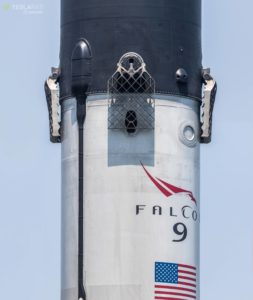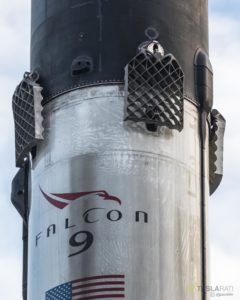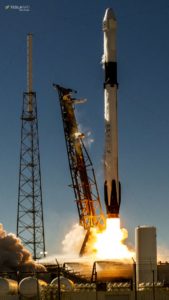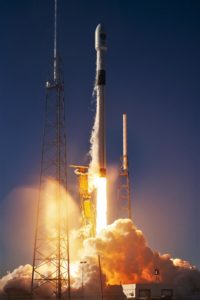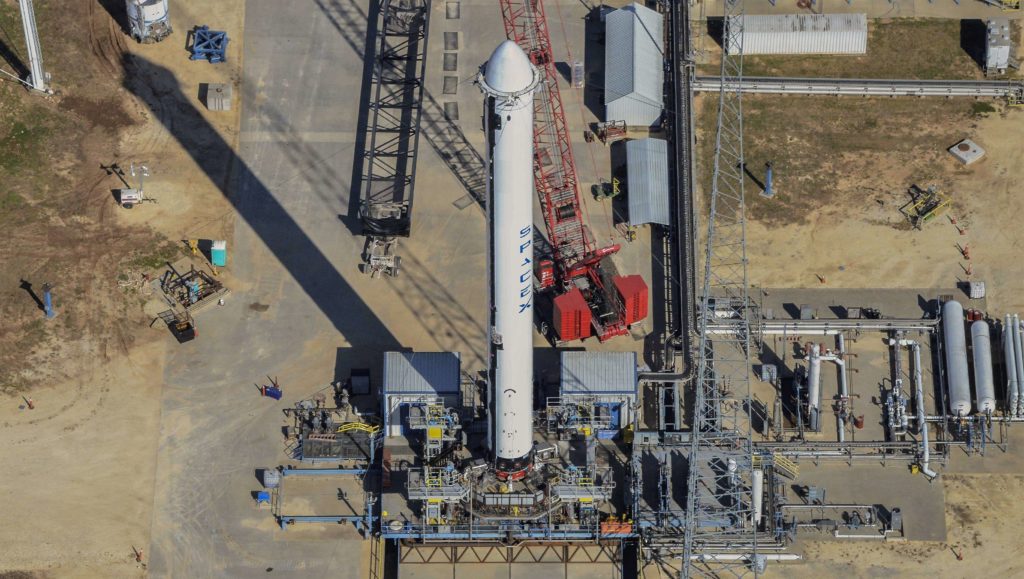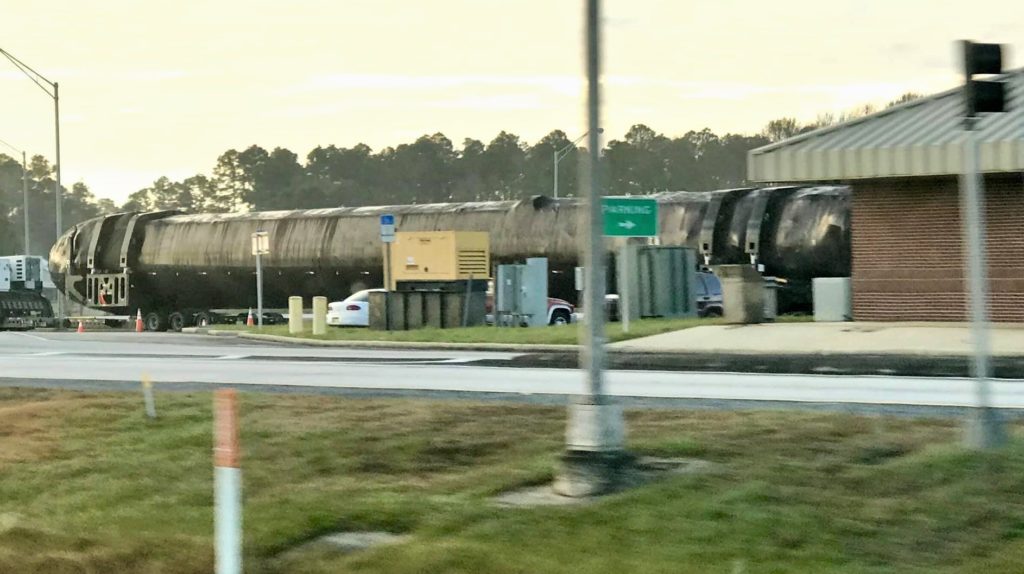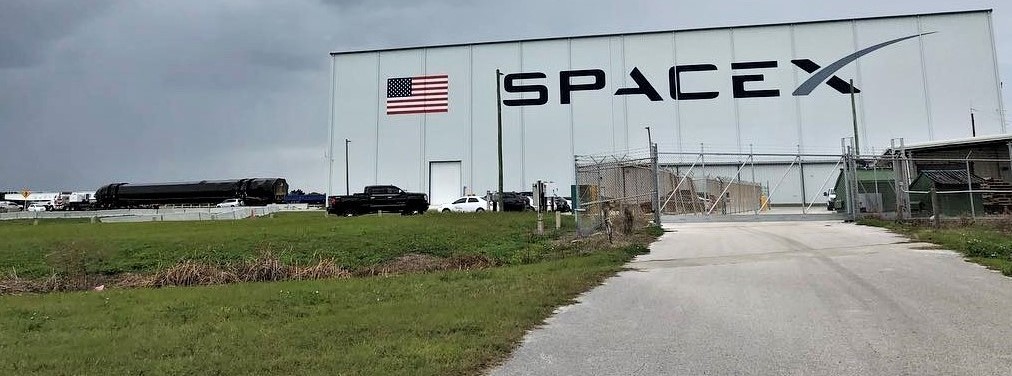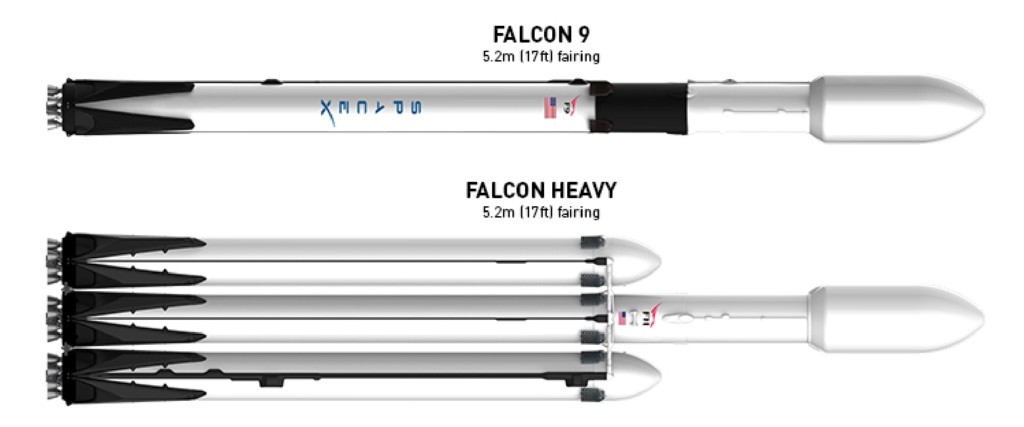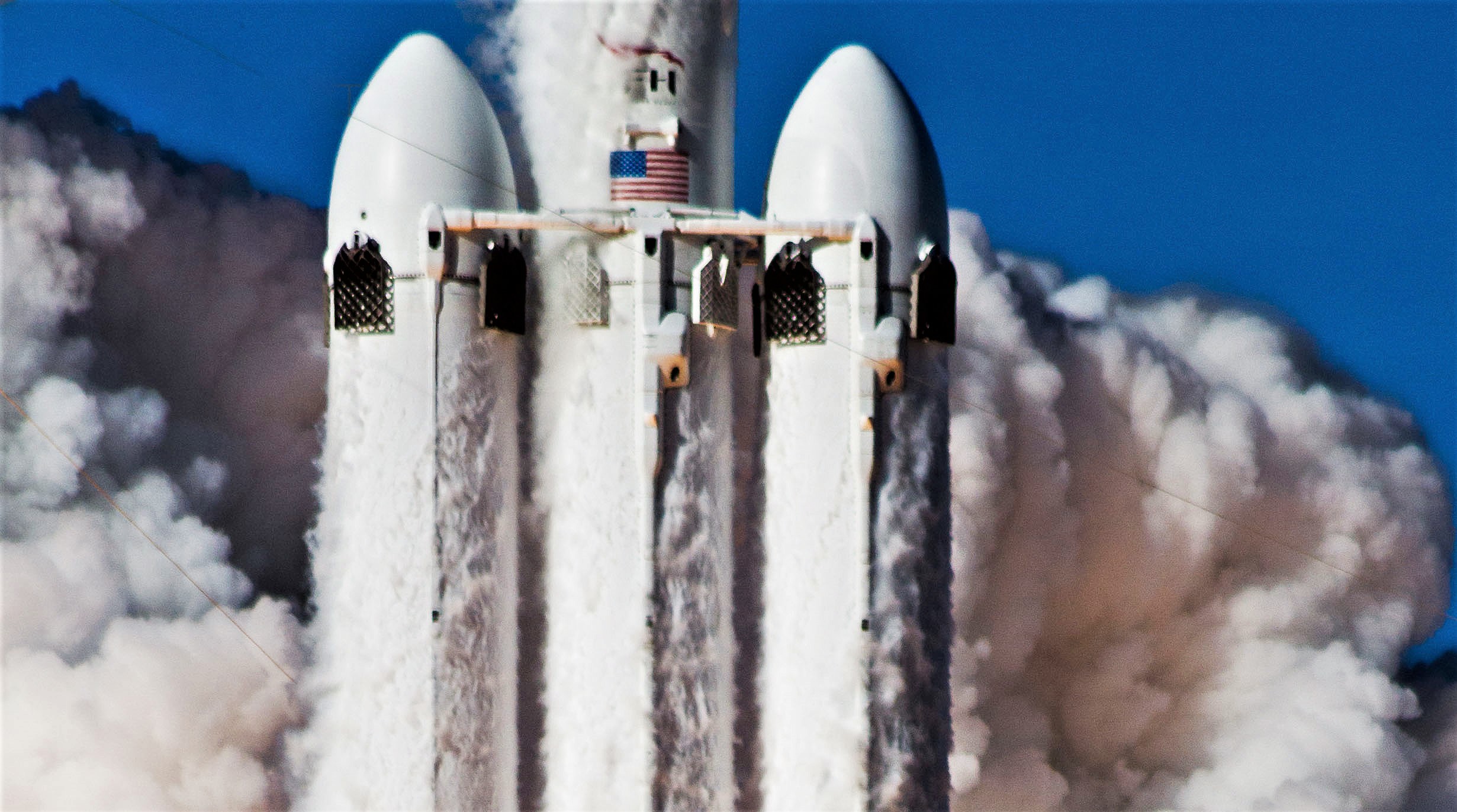

News
SpaceX’s next Falcon Heavy launch may feature record-breaking center core landing
Thanks to a temporary reopening of the US federal government, SpaceX was finally able to continue the process of filing FCC and FAA paperwork needed to acquire permits for upcoming launches, including Falcon Heavy.
One such filing related to the first operational Falcon Heavy launch has revealed a fairly impressive statistic: comprised of three first stage boosters, SpaceX indicated that Falcon Heavy’s center core will attempt to land on drone ship Of Course I Still Love You (OCISLY) nearly 1000 km (600 mi) away from its launch site, easily smashing the record for the greatest distance traveled by a Falcon booster in flight.
Of Course I Still Love You will be positioned a record ~965km downrange. That's nearly 300km further that the previous greatest distance of 681km, set during the Eutelsat-117WB mission in June 2016. (The landing was a failure, with the booster running out of LOX!) https://t.co/RECKjMtd37
— Gav Cornwell (@SpaceOffshore) January 28, 2019
The same FCC filings also revealed a No Earlier Than (NET) launch date: March 7, 2019. Originally targeted for mid to late February, the complexity and logistical challenges of building, shipping, testing, and delivering two side boosters, a center core, one upper stage, and a payload fairing from SpaceX’s California factory to its Texas test facilities and Florida launch pad unsurprisingly took a small toll on the launch’s aspirational schedule. Nevertheless, if the launch data actually holds to March 7th, SpaceX will not have missed the mark by much considering that this Falcon Heavy – based on new and more powerful Block 5 boosters – is likely a significant departure from the Block 2/Block 3 hardware that has flight heritage from the triple-booster rocket’s Feb. 2018 launch debut.

Just shy of a year after Falcon Heavy’s launch debut, it appears that the rocket’s second and third launches were pushed back by a fundamental lack of production capacity. In other words, SpaceX’s Hawthorne rocket factory simply had to focus on more critical priorities in the 6-9 months that followed the demo mission. At nearly the same time as Falcon Heavy was lifting off for the first time, SpaceX’s world-class production crew was in the midst of manufacturing the first upgraded Falcon 9 Block 5 booster (B1046) and wrapped up final checkouts just 10 days after Heavy’s Feb. 6 launch debut, sending the pathfinder rocket to McGregor, Texas for the first static fire of a Block 5 booster.
In the meantime, SpaceX’s decision to intentionally expend otherwise recoverable reused Falcon boosters after their second launches meant that the company’s fleet of flightworthy rockets was rapidly approaching zero, a move CEO Elon Musk specifically indicated was meant to make room for Block 5, the future (and final form) of the Falcon family. SpaceX’s busy 2018 launch manifest and multiple critical missions for the US government were thus balanced on the success, reliability, and rapid production of a serious number of Merlin engines, boosters, and upper stages. This included B1051 – the first explicitly crew-rated Falcon 9 – and B1054, the first SpaceX rocket rated to launch high-value US military (specifically Air Force) satellites. However, SpaceX also needed to produce a cadre of Falcon 9 boosters capable of easy reuse to support the dozen or so other commercial launches on the manifest.
- Falcon 9 B1046 is processed in Port of LA shortly after its third successful launch and landing, December 2018. (Pauline Acalin)
- Falcon 9 B1047 is pictured here beneath an upper stage and satellite Es’hail-2 prior to its second launch. (Tom Cross)
- Falcon 9 B1048 returned to Port of Los Angeles aboard drone ship Just Read The Instructions after its first launch. July 27. (Pauline Acalin)
- Falcon 9 B1049 returned to Port of Los Angeles after its second successful launch and landing in four months. (Pauline Acalin)
- Falcon 9 B1050 is seen here just after liftoff. GPS III SV01’s Falcon 9 will feature no grid fins or landing legs. ☹ (Tom Cross)
- Falcon 9 B1051 and Crew Dragon vertical at Pad 39A. (SpaceX)
That gamble ultimately paid off, with Block 5 performing admirably and supporting a reasonable – if not record-breaking – rate of reuse. SpaceX successfully launched B1054 for the USAF, completed B1051 (now at Pad 39A awaiting NASA’s go-ahead), and built enough reusable Block 5 boosters to support nine additional commercial missions in 2018. In hindsight, barring an assumption of a truly miraculous and unprecedented Falcon booster production rate, Falcon Heavy’s next launches were almost guaranteed to occur no fewer than 6-12 months after the rocket’s launch debut – SpaceX’s entire launch business depended on building 5+ unrelated Falcon 9 boosters, while Falcon Heavy customers Arabsat and the USAF were unlikely to be swayed to launch on flight-proven hardware so early into Block 5’s career.
https://twitter.com/_TomCross_/status/1048483536917823488
All cylinders firing
Once Falcon 9 B1054 departed SpaceX’s Hawthorne factory (see above) in early October, it appears that the company’s production team pivoted directly to integrating and shipping the next three (or more) Falcon Heavy boosters back to back for the rocket’s second and third launches. The first new side booster departed the factory in mid-November, followed by a second side booster in early December and a (presumed but highly likely) center core at the turn of 2019. Both side boosters have been static-fired in Texas and are now at SpaceX’s Florida facilities, while the center core either just completed its Texas static fire testing or is already on its way East.
- SpaceX’s Falcon Heavy Block 5 side booster is pictured here in Texas in November 2018. (Teslarati/Aero Photo)
- The second (and third) flight of Falcon Heavy is even closer to reality as a new side booster heads to Florida after finishing static fire tests in Texas. (Reddit /u/e32revelry)
- SpaceX Facebook group member Joshua Murrah captured the second Falcon Heavy side booster to arrive in Florida in the last month. (Joshua Murrah, 01/17/19)
- The next Falcon Heavy’s first side booster delivery was caught by several onlookers around December 21. (Instagram)
- A booster – likely the next Falcon Heavy center core – was vertical at McGregor’s S1 static fire stand. (Instagram /u/tcryguy)
- A booster – either Falcon Heavy’s next center core or a new Falcon 9 – was vertical at SpaceX’s McGregor, TX test facilities on Jan 28. (Instagram /u/n75sd)
- A diagram from a recent SpaceX document offers an idea of what Falcon Heavy Block 5 will look like. (SpaceX)
Once the center core and upper stage make their way to SpaceX’s Kennedy Space Center Pad 39A, the company’s technicians and engineers will be able to integrate the second Falcon Heavy to have ever existed in preparation for a critical static fire test. That could occur as early as February, although the launch debut of Crew Dragon (DM-1) – now NET March from Pad 39A after a relentless string of slips – will likely take precedence over Falcon Heavy and could thus directly interfere with its launch, as the launch pad and transporter/erector (T/E) has to undergo at least a few days of modifications to switch between Falcon 9 and Heavy.
Regardless, the next two Falcon Heavy launches will be well worth the wait. SpaceX’s FCC filings indicate that the center core may travel nearly 1000 km (600 mi) East of Pad 39A to land on drone ship OCISLY after launch, smashing the previous record attempt – during the June 2016 launch of Eutelsat 117WB – of ~700 km (430 mi). That Falcon 9 booster – albeit a less-powerful Block 2 variant – was unsuccessful in its landing attempt, running out of oxidizer seconds before landing. Falcon Heavy’s debut center core also happened to suffer a wholly different but no less fatal anomaly during landing, causing it to miss the drone ship and slam into the Atlantic Ocean at almost half the speed of sound (300 mph/480 km/h).
Looks like early liquid oxygen depletion caused engine shutdown just above the deck pic.twitter.com/Sa6uCkpknY
— Elon Musk (@elonmusk) June 17, 2016
Known for their rocket performance estimates, NASASpaceflight forum user “Orbiter” first pointed out the impressive distance – gathered by mapping coordinates included in SpaceX’s Jan. 28th FCC filing – and estimated that the Falcon Heavy center booster flying a trajectory as implied could be traveling as fast as ~3.5 km/s (2.2 mi/s) at main engine cut-off (MECO), the point at which the booster separates from the upper stage and fairing. This would be a nearly unprecedented velocity for any Falcon booster, let alone a booster with plans to land after launch. Falcon 9 MECO typically occurs at velocities between 1.5 and 2.5 km/s for recoverable missions, while even the recent expendable GPS III launch saw F9 S1’s engines cut off around 2.7 km/s.
Whether that MECO velocity estimate is correct, Falcon Heavy’s NET March launch of the ~6000 kg (13,300 lb) Arabsat 6A satellite is likely to be an exceptionally hot reentry and recovery for the center core, while the rocket’s duo of side boosters will attempt a repeat of the debut mission’s spectacular double-landing at LZ-1.

Elon Musk
Elon Musk and Tesla AI Director share insights after empty driver seat Robotaxi rides
The executives’ unoccupied tests hint at the rapid progress of Tesla’s unsupervised Robotaxi efforts.

Tesla CEO Elon Musk and AI Director Ashok Elluswamy celebrated Christmas Eve by sharing personal experiences with Robotaxi vehicles that had no safety monitor or occupant in the driver’s seat. Musk described the system’s “perfect driving” around Austin, while Elluswamy posted video from the back seat, calling it “an amazing experience.”
The executives’ unoccupied tests hint at the rapid progress of Tesla’s unsupervised Robotaxi efforts.
Elon and Ashok’s firsthand Robotaxi insights
Prior to Musk and the Tesla AI Director’s posts, sightings of unmanned Teslas navigating public roads were widely shared on social media. One such vehicle was spotted in Austin, Texas, which Elon Musk acknowleged by stating that “Testing is underway with no occupants in the car.”
Based on his Christmas Eve post, Musk seemed to have tested an unmanned Tesla himself. “A Tesla with no safety monitor in the car and me sitting in the passenger seat took me all around Austin on Sunday with perfect driving,” Musk wrote in his post.
Elluswamy responded with a 2-minute video showing himself in the rear of an unmanned Tesla. The video featured the vehicle’s empty front seats, as well as its smooth handling through real-world traffic. He captioned his video with the words, “It’s an amazing experience!”
Towards Unsupervised operations
During an xAI Hackathon earlier this month, Elon Musk mentioned that Tesla owed be removing Safety Monitors from its Robotaxis in Austin in just three weeks. “Unsupervised is pretty much solved at this point. So there will be Tesla Robotaxis operating in Austin with no one in them. Not even anyone in the passenger seat in about three weeks,” he said. Musk echoed similar estimates at the 2025 Annual Shareholder Meeting and the Q3 2025 earnings call.
Considering the insights that were posted Musk and Elluswamy, it does appear that Tesla is working hard towards operating its Robotaxis with no safety monitors. This is quite impressive considering that the service was launched just earlier this year.
Elon Musk
Starlink passes 9 million active customers just weeks after hitting 8 million
The milestone highlights the accelerating growth of Starlink, which has now been adding over 20,000 new users per day.

SpaceX’s Starlink satellite internet service has continued its rapid global expansion, surpassing 9 million active customers just weeks after crossing the 8 million mark.
The milestone highlights the accelerating growth of Starlink, which has now been adding over 20,000 new users per day.
9 million customers
In a post on X, SpaceX stated that Starlink now serves over 9 million active users across 155 countries, territories, and markets. The company reached 8 million customers in early November, meaning it added roughly 1 million subscribers in under seven weeks, or about 21,275 new users on average per day.
“Starlink is connecting more than 9M active customers with high-speed internet across 155 countries, territories, and many other markets,” Starlink wrote in a post on its official X account. SpaceX President Gwynne Shotwell also celebrated the milestone on X. “A huge thank you to all of our customers and congrats to the Starlink team for such an incredible product,” she wrote.
That growth rate reflects both rising demand for broadband in underserved regions and Starlink’s expanding satellite constellation, which now includes more than 9,000 low-Earth-orbit satellites designed to deliver high-speed, low-latency internet worldwide.
Starlink’s momentum
Starlink’s momentum has been building up. SpaceX reported 4.6 million Starlink customers in December 2024, followed by 7 million by August 2025, and 8 million customers in November. Independent data also suggests Starlink usage is rising sharply, with Cloudflare reporting that global web traffic from Starlink users more than doubled in 2025, as noted in an Insider report.
Starlink’s momentum is increasingly tied to SpaceX’s broader financial outlook. Elon Musk has said the satellite network is “by far” the company’s largest revenue driver, and reports suggest SpaceX may be positioning itself for an initial public offering as soon as next year, with valuations estimated as high as $1.5 trillion. Musk has also suggested in the past that Starlink could have its own IPO in the future.
News
NVIDIA Director of Robotics: Tesla FSD v14 is the first AI to pass the “Physical Turing Test”
After testing FSD v14, Fan stated that his experience with FSD felt magical at first, but it soon started to feel like a routine.

NVIDIA Director of Robotics Jim Fan has praised Tesla’s Full Self-Driving (Supervised) v14 as the first AI to pass what he described as a “Physical Turing Test.”
After testing FSD v14, Fan stated that his experience with FSD felt magical at first, but it soon started to feel like a routine. And just like smartphones today, removing it now would “actively hurt.”
Jim Fan’s hands-on FSD v14 impressions
Fan, a leading researcher in embodied AI who is currently solving Physical AI at NVIDIA and spearheading the company’s Project GR00T initiative, noted that he actually was late to the Tesla game. He was, however, one of the first to try out FSD v14.
“I was very late to own a Tesla but among the earliest to try out FSD v14. It’s perhaps the first time I experience an AI that passes the Physical Turing Test: after a long day at work, you press a button, lay back, and couldn’t tell if a neural net or a human drove you home,” Fan wrote in a post on X.
Fan added: “Despite knowing exactly how robot learning works, I still find it magical watching the steering wheel turn by itself. First it feels surreal, next it becomes routine. Then, like the smartphone, taking it away actively hurts. This is how humanity gets rewired and glued to god-like technologies.”
The Physical Turing Test
The original Turing Test was conceived by Alan Turing in 1950, and it was aimed at determining if a machine could exhibit behavior that is equivalent to or indistinguishable from a human. By focusing on text-based conversations, the original Turing Test set a high bar for natural language processing and machine learning.
This test has been passed by today’s large language models. However, the capability to converse in a humanlike manner is a completely different challenge from performing real-world problem-solving or physical interactions. Thus, Fan introduced the Physical Turing Test, which challenges AI systems to demonstrate intelligence through physical actions.
Based on Fan’s comments, Tesla has demonstrated these intelligent physical actions with FSD v14. Elon Musk agreed with the NVIDIA executive, stating in a post on X that with FSD v14, “you can sense the sentience maturing.” Musk also praised Tesla AI, calling it the best “real-world AI” today.


